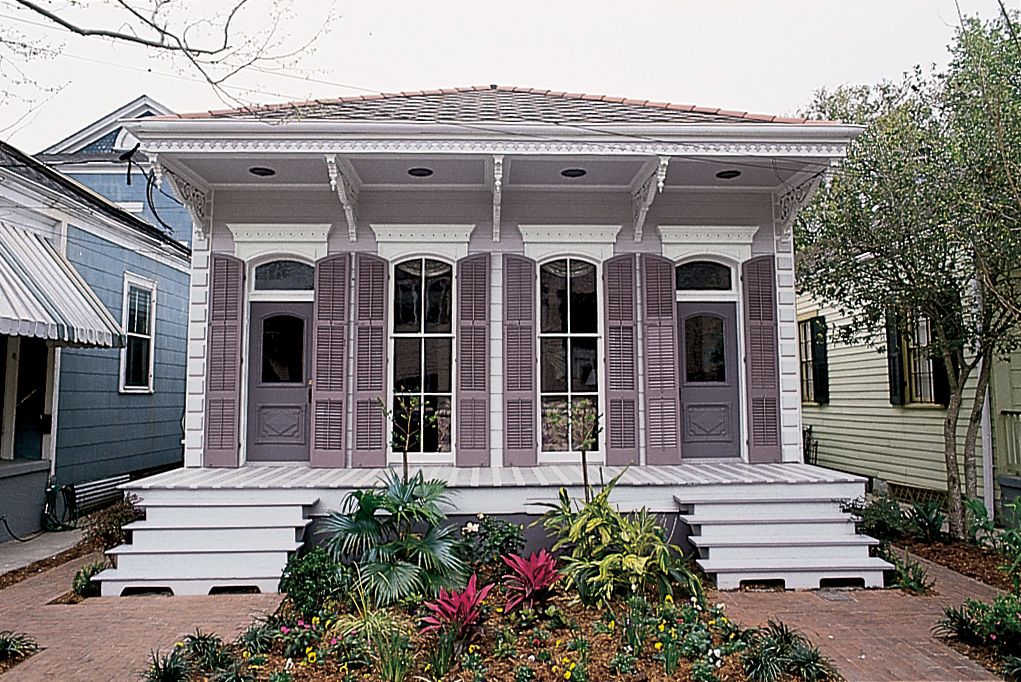Soon after wrapping up Hazel Briceno’s Boston triple-decker project, we hopped a plane to New Orleans. Crawfish, gumbo, jambalaya, oysters? Yes, but we were also there to help homeowners Elvis and Jean Golden convert their “shotgun double” house of two separate apartments into a single home.
The Goldens, both with the U.S. Navy in New Orleans, bought their home in the Algiers Point neighborhood soon after they were transferred to the city in mid-1990. The $35,000 purchase price bought them a piece of New Orleans history, the shotgun house being one of the city’s most enduring forms of vernacular architecture. In the late 19th and early 20th centuries, shotguns went up by the thousands, their long and narrow configuration ideally suited for the tight lots of the land-tight, waterbound city. The succession of rooms their narrowness prescribed gave them their name: it was said that a shotgun blast fired from the front doorway would travel uninterrupted through the house and out the back door.
The Goldens’ house was built in 1892 and was in remarkably good shape. Aside from a small amount of termite damage on the front porch and an archaic system of underfloor grated gas heaters, the major challenge it presented was its floorplan. As a “double” shotgun, it had two mirror-image apartments running side-by-side the entire length of the 76-foot-deep structure. Elvis, then 26, and Jean, 33, and their three children wanted to unify the two halves into a spacious, three-bedroom, two-bathroom home of about 2,000 square feet. Armed with a very small budget of $20,000, they decided to act as their own architects and general contractors, rolling up their sleeves with us to knock down walls, reframe and update the interior.
Plumbing and heating contractor Richard Trethewey oversaw the installation of the two bathrooms, a kitchen island and an HVAC system using a heat pump for the region’s mild winters and central air conditioning for the brutal summers.
Under the aluminum siding, Victorian charm lurked. We restored the front porch and façade and rehabilitated the elaborate ceiling brackets. A trip to a wonderful salvage yard in town yielded just the right decorative window pediments to replace those lost when the aluminum went up, as well as some gingerbread trim to dress up the front fascia. Victorian paint color expert Louis Aubert suggested a plum and lavender scheme that featured a two-toned stripe effect on the porch floorboards.
Inside, a specialist crew gave extra attention to bringing back the longleaf yellow pine floors; we reactivated the old pocket doors between the new living room and parlor spaces; and the Goldens got a well-designed modern kitchen that nonetheless fit their budget.
Providing a fascinating backdrop to the project, New Orleans and its environs were the subject of several field trips, including the antebellum plantation mansion Oak Alley and the Gallier House, the crowning Victorian architectural jewel of the French Quarter. We visited the workshop where many of the famous Mardi Gras parade floats are made, and Richard Trethewey investigated the city’s extensive water-pumping facilities to show how New Orleans survives at five feet below sea level. At a treatment plant, Richard also witnessed one of the great miracles of life in the Crescent City—the conversion of water from the muddy Mississippi into drinking water.
The house’s transformation continued even after our departure. The Goldens redid the mulberry master bedroom in a navy floral wallpaper. Subsequent owners pulled the paper, painted the room salmon and even switched the front porches’ scheme from two-toned Victorian lavender to steel gray. Finally, the house fell into the hands of avid TOH fans, who slowly brought the house back to its original restored state. Which goes to show you that even after a project wraps, the renovation continues.

